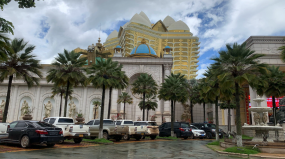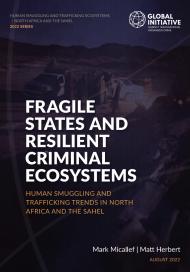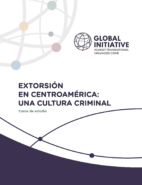Human trafficking is the most pervasive illicit market in the world. In Latin America, the situation is particularly acute. Countries need to work together to respond to this growing threat.
The 2021 Global Organized Crime Index revealed disturbing findings about some of the world’s most profitable criminal economies, not least the fact that human trafficking is the most pervasive global illicit market. With a criminal score of 5.8 in the Index, this activity has surpassed the illegal cannabis trade and arms trafficking, markets, which have average global criminality scores of 5.10 and 4.92, respectively.
In recent years, the pervasiveness of the human trafficking market globally has been fuelled by factors such as the COVID-19 pandemic and the ensuing economic crisis, and the emergence of technologies that help criminals stay largely undetected. However, it is in Latin America, one of the most unequal regions in the world, where the situation is particularly daunting.
In Mexico in particular, the number of victims of human trafficking has risen sharply in recent years, with a spike in 2020. One report has documented the rise, citing information from Mexico’s Executive Secretariat for Public Security, which identified at least 550 victims of trafficking in 2020, up from 383 in 2016. The reality is that these numbers are likely to be higher, as many cases go unreported. According to the study, Mexico is a transit country for human trafficking, primarily of victims from Central America being trafficked for sexual exploitation or forced labour.
The pandemic also exacerbated other phenomena that can lead to human trafficking, such as the rise in irregular migration along the corridor that runs across Mexico to the US, which is largely controlled by criminal organizations that often operate in collusion with local authorities.
Guadalupe Correa-Cabrera, an expert on organized crime and human trafficking, has warned that the situation could deteriorate, as the number of vulnerable people attempting to cross the Mexico–US border increased exponentially in the first months of 2022 and is likely to continue to rise. The lack of attention given to this illicit economy makes it challenging to tackle, particularly compared with other criminal markets such as drug trafficking, which is more visible and tends to trigger policy responses – albeit not necessarily always effective ones. ‘Priorities and resources are not dedicated to human trafficking,’ said Correa-Cabrera. ‘There are no detailed studies about where it happens or the link between people on the move and other factors in a world in crisis. Policies at the global level are focused on other [illicit] markets.’
A transnational response
Human trafficking is an extremely challenging criminal economy to tackle in the best of circumstances. But in Latin America, and Mexico in particular, responses are even more complicated owing to the presence of some of the most powerful transnational criminal organizations in the world, high levels of corruption and lack of efficient resilience tools. Combined with a rising number of people who are vulnerable to exploitation and nearly non-existent conviction rates for those accused of people trafficking, this creates an environment that enables abuses to flourish.
To investigate and prosecute human trafficking effectively, countries need to equip their investigative units with sophisticated tools and techniques; implement mechanisms to prevent and punish rampant corruption; and improve coordination efforts with other countries in terms of investigations and prosecutions. As a transnational crime, human trafficking must be met with a transnational response. Latin American countries do not address this criminal economy beyond their own borders, and this contributes to the problem.
Public debate and shared insight on the organizations driving this market, issues and populations affected, and information about how to safely report these crimes when they happen are essential if governments in the region are serious about prevention and ensuring justice for victims. In addition, civil society actors are often those with the greatest understanding of these issues and challenges, and they therefore need to be included in the development of actionable policy solutions to tackle this market. Countries should work more closely with civil society organizations to formulate better responses.
The absence of public attention and debate around human trafficking leads to a lack of effective and comprehensive strategies to prevent this phenomenon and help survivors, which enables criminal organizations to operate. In a challenging post-pandemic world, particularly as the number of people migrating along dangerous routes increases, governments must rise to the challenge and join efforts to tackle this criminal market. Understanding how the organizations driving this market operate; improving legislation so it can be effective across borders; and implementing policies to ensure vulnerable people do not become victims are three important first steps.
This analysis is part of the GI-TOC’s series of articles delving into the results of the Global Organized Crime Index 2021. The series explores the Index’s findings and their effects on policymaking, anti-organized crime measures and analyses from a thematic or regional perspective.
Ojos que no ven, corazón que no siente: La lucha de Latinoamérica contra la trata de personas
La trata de personas es el mercado ilícito más extendido del mundo. En Latinoamérica, la situación es especialmente grave. Los países deben trabajar juntos para responder a esta creciente amenaza.
El Índice Global de Crimen Organizado 2021 mostró resultados preocupantes sobre algunas de las economías criminales más rentables del mundo, entre los que destaca el hecho de que la trata de personas es el mercado ilícito global más omnipresente. Con una puntuación en criminalidad de 5.8 de acuerdo con el Índice, esta actividad ha superado al comercio ilegal de cannabis y al tráfico de armas, mercados que tienen puntuaciones medias de criminalidad global de 5.10 y 4.92, respectivamente.
En años recientes, la omnipresencia global del mercado de trata de personas ha sido alimentada por factores como la pandemia por COVID-19 y la crisis económica que trajo consigo, así como por el surgimiento de tecnologías que ayudan a los criminales a pasar prácticamente desapercibidos. Sin embargo, es en Latinoamérica, una de las regiones con mayor desigualdad en el mundo, donde la situación es particularmente desalentadora.
Ejecutivo del Sistema Nacional de Seguridad Pública, que identificó por lo menos 550 víctimas de trata en 2020, frente a las 383 del 2016. La realidad es que estos números probablemente sean más altos, pues muchos casos no se reportan. De acuerdo con el estudio, México es un país de tránsito para la trata de personas, principalmente víctimas provenientes de Centroamérica que son traficadas para explotación sexual o trabajo forzado.
La pandemia también ha exacerbado otros fenómenos que pueden conducir a la trata de personas, como el aumento en la migración a lo largo del corredor que cruza México hacia los Estados Unidos, controlado en su mayoría por organizaciones que frecuentemente operan en colusión con las autoridades.
Guadalupe Correa-Cabrera, experta en crimen organizado y trata de personas, ha advertido que la situación podría deteriorarse dado que el número de personas vulnerables que intentan cruzar la frontera México-Estados Unidos creció exponencialmente en los primeros meses del 2022 y probablemente seguirá en aumento. La falta de atención que se da a esta economía criminal presenta un reto para combatirla, particularmente comparada con otros mercados criminales como el tráfico de drogas, que es más visible y tiende a generar respuestas políticas, aunque no necesariamente sean efectivas. «Las prioridades y los recursos no están enfocados en la trata de personas», comentó Correa-Cabrera. «No hay estudios detallados sobre dónde sucede o sobre el vínculo entre las personas que se desplazan y otros factores en un mundo en crisis. Las políticas globales están dirigidas a otros mercados (ilícitos)».
Una respuesta transnacional
La trata de personas es un mercado criminal extremadamente difícil de abordar en las mejores circunstancias. Pero en Latinoamérica, y México en particular, enfrentarlo se complica aún más debido a la presencia de algunas de las más poderosas organizaciones criminales transnacionales en el mundo, a los altos niveles de corrupción y a la falta de herramientas eficientes para la construcción de resiliencia. Esto, combinado con un creciente número de personas vulnerables a la explotación y altos niveles de impunidad para quienes son acusados de trata, crea un ambiente que permite que el abuso prospere.
Para investigar y perseguir la trata de personas de forma efectiva, los países necesitan equipar a sus unidades de investigación con herramientas y técnicas sofisticadas; implementar mecanismos que prevengan y castiguen la corrupción desenfrenada; y mejorar los esfuerzos de coordinación con otros países en términos de investigación y persecución. Al tratarse de un crimen transnacional, la trata de personas debe enfrentarse con respuestas transnacionales. Los países de Latinoamérica no reconocen esta economía criminal más allá de sus propias fronteras, lo que contribuye al problema.
Si los gobiernos de la región buscan prevenir seriamente este delito y asegurar justicia para las víctimas es fundamental promover el debate público y compartir conocimiento sobre las organizaciones que impulsan este mercado, sus problemas y poblaciones afectadas, así como generar información sobre cómo denunciar estos crímenes de forma segura. Además, los actores de la sociedad civil suelen ser los que mejor conocen estos problemas y desafíos, por lo que es necesario incluirlos en el desarrollo de soluciones políticas factibles para hacer frente a este mercado. Los países deberían colaborar más estrechamente con las organizaciones de la sociedad civil para formular mejores respuestas.
La falta de atención pública y debate alrededor de la trata de personas conduce a la falta de estrategias efectivas y exhaustivas para prevenir este fenómeno y apoyar a los sobrevivientes, lo que permite operar a las organizaciones criminales. En un mundo pospandémico lleno de desafíos, especialmente a medida que aumenta el número de personas que emigran por rutas peligrosas, los gobiernos deben estar a la altura del reto y coordinar esfuerzos para hacer frente a este mercado criminal. Entender cómo operan las organizaciones que impulsan este mercado, mejorar la legislación para que pueda ser eficaz a través de las fronteras y aplicar políticas que garanticen que las personas vulnerables no se conviertan en víctimas, son los tres primeros pasos.
Este análisis es parte de una serie de artículos de GI-TOC que profundizan en los resultados del Índice global de crimen organizado 2021. Esta serie explora los hallazgos del Índice y sus efectos en el desarrollo de políticas públicas, en las medidas contra el crimen organizado y aporta análisis desde una perspectiva temática o regional.



